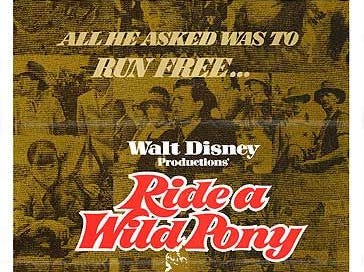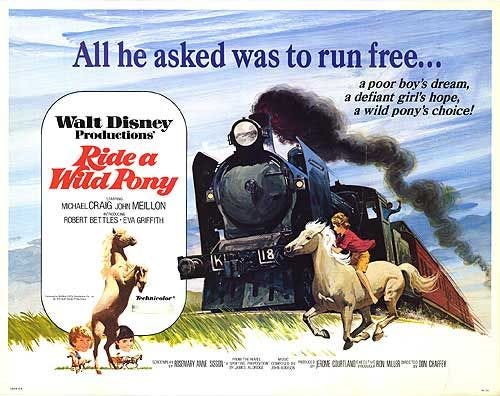Disney Plus-Or-Minus: Ride A Wild Pony
When Walt Disney first ventured into live-action film production with 1950’s Treasure Island, their first several projects were shot entirely on location in England. This was more a matter of necessity than an artistic choice. The company had funds tied up overseas and post-World War II economic recovery laws required them to spend British money in Britain. But since then, the studio had tried to stay as close to their Southern California home as possible. There were some exceptions. Nature films, obviously, had to go where the animals were. And California, as versatile as it is, couldn’t believably fill in for locations like the Matterhorn in Third Man On The Mountain, Greece in The Moon-Spinners or Hawaii in The Castaway Cowboy. Even so, the studio did their best to keep travel to a minimum.
Ride A Wild Pony could have been just another Disney movie shot in and around Burbank. Based on the novel A Sporting Proposition by Australian writer James Aldridge, the studio’s original plan was to Americanize the story. But producer Jerome Courtland (last seen in this column producing Escape To Witch Mountain) decided to keep the Australian setting and shoot the movie Down Under with a primarily local cast and crew.
At the time, this was a somewhat unusual choice. The Australian film industry had seen its shares of ups and downs since its formation and the 1960s had been a particularly rough decade. The country was actively taking steps to turn that around with the formation of the Australian Film Development Corporation in 1970. At the same time, the filmmakers of the Australian New Wave, including Bruce Beresford and Peter Weir, were just beginning to emerge. Having a major Hollywood studio, even one as bruised and battered as Disney was in 1975, invest in Australian film was a big deal.
Courtland hired Rosemary Anne Sisson to adapt Aldridge’s book into a screenplay. Sisson had been a writer for British television, most notably on the highly acclaimed Upstairs, Downstairs, which became a big hit for PBS in the US. Ride A Wild Pony was Sisson’s first Disney assignment and first feature film credit but not her last. We’ll see her work several more times.
To direct, Courtland reached out to Don Chaffey, who hadn’t made a Disney film since The Three Lives Of Thomasina in 1963. Since then, Chaffey had returned to England where he made a few movies for Hammer (including One Million Years B.C., whose iconic poster was a dorm room staple in the late 60s) and a lot of television like Danger Man (a.k.a. Secret Agent) and The Prisoner. Ride A Wild Pony not only marked Chaffey’s return to Disney, it was also the first of several projects he directed in Australia.
Even the biggest names in the cast wouldn’t have been too familiar to American audiences. Michael Craig was well-known in England and he’d shared an Academy Award nomination as one of the writers of the 1960 British drama The Angry Silence, in which he also appeared. His biggest Hollywood role had been in Julie Andrews’ 1968 musical Star!, a major disappointment at the box office. John Meillon was an Australian actor who’d appeared in such films as Wake In Fright, Walkabout and The Cars That Ate Paris, as well as some American productions like The Sundowners that had been filmed in the country.
It's easy to see how Disney could have transposed Ride A Wild Pony to America without affecting the story much at all. The Australianness of the film comes across mostly in the accents, the landscapes and the mobs of kangaroos hopping all over the place. (I love that a group of roos is referred to as a “mob”. That just feels right.) The story itself is fairly universal, especially in frontier countries like Australia and the US. As long as there are haves and have-nots, you can tell this story.
Young Robert Bettles stars as Scott Pirie, a mischievous kid who lives with his dirt-poor family on a remote farm. Bettles made one more Disney appearance in the TV production Born To Run, released theatrically overseas as Harness Fever. He also reunited with director Chaffey and many of his Ride A Wild Pony costars in the family drama The Fourth Wish, written by Michael Craig. Bettles didn’t stay in show business for long. His last movie, a surfing flick called Shimmering Light also directed by Chaffey, came out in 1978.
We first encounter Scotty leaping on to the back of a wild pony and taking it for a joyride. But when the law shows up at the family farm to deliver a summons, it has nothing to do with attempted horse rustling. It’s a truant officer demanding to know why Scotty hasn’t shown up to school for months.
Scott’s father, Angus (Alfred Bell), is a proud man of few words but he journeys into town to ask the town’s solicitor, Charles Quayle (Meillon), for help. Angus explains that it’s a seven-mile trek to the school and the Piries can’t afford to buy a horse. If they want Scotty at school that badly, then they’re going to have to figure out a way to get him there.
Quayle works out a solution by getting local rich and powerful ranch-owner James Ellison (Craig) to donate a Welsh Pony to the Piries. At first, Angus refuses to take the horse, saying he won’t accept charity. But when Quayle works out a deal to sell him the horse for the rock-bottom price of three pounds, they’re able to work out an agreement. Since the unbroken pony has a bit of a temperament, it wasn’t as if the rancher was going to get much out of him anyway.
Scotty quickly becomes attached to the pony, whom he names Taff. The rest of the town isn’t quite as enamored of either the boy or his horse. Scott’s inherently wild nature allows him to indulge the horse’s worst instincts. Between dangerous stunts like racing trains and tearing down narrow streets at top speed, the pair leave a path of destruction wherever they go. Still, at least Scott’s back in school and the horse does respond to him when he wants to. So when Taff disappears from the Piries’ property, Scott single-mindedly heads out looking for him without telling a soul.
Meanwhile, on the other end of the economic spectrum, Ellison is completely devoted to his daughter, Josie, wheelchair-bound since being struck by polio two years earlier. Eva Griffith plays Josie in her only Disney appearance. Griffith’s acting career lasted longer than Bettles’ did, particularly on the stage. She eventually went into academia and today, Dr. Eva Griffith is a highly respected theatre historian.
Josie has become a moody recluse since losing the use of her legs. The only pleasure she finds is in her father’s horses. Since it seems she’ll never ride again, Ellison suggests fixing up a little yellow cart and finding a pony to pull it. Josie selects a pony that looks exactly like Taff and takes it upon herself to train the animal. She names (or renames) him Beau and, like Scotty, falls in love with the horse.
After a couple weeks of fruitless searching, Scotty returns home to his furious father and distraught mother (Melissa Jaffer, who would appear as the Keeper of the Seeds in Mad Max: Fury Road many years later). Scott is forced to go back to school with or without his horse. He isn’t happy about the situation but makes the best of it thanks to his new friend, Quayle’s son, Kit (played by Meillon’s actual son, John Meillon Jr.).
Kit and Scotty attend the town fair where Scott spots Josie in her spiffy new cart being pulled by Beau. Scott freaks out, screaming that the horse is Taff and belongs to him. He’s carted off by the police but enough people, including Kit and Angus, believe that Scott’s right. So Angus once again asks Quayle to represent him in court to determine the horse’s true identity.
Under cross-examination, both Scott and Josie make compelling arguments for ownership of Taff/Beau. Quayle suggests to the judge that no one would be able to conclusively prove which horse this is and proposes the court let the horse decide. Everyone agrees this sounds like an equitable solution. Of course, since this is a small town, everyone has an opinion on the matter and bets are soon placed on which child the horse will choose.
A staging area is set up with Scott and Josie instructed to sit still on opposite sides. After a few moments of indecision, Taff picks Scotty as his master. Even Josie respects the decision and admits she never would have selected Taff in the first place if she’d known he already belonged to Scotty. Scott, appreciative of Josie for accepting defeat graciously, promises to come visit frequently and let her drive her cart around.
Ride A Wild Pony is not what I would consider top-shelf Disney. There’s just not a lot of meat on the bone here. It’s also a little maddening how long everyone keeps referring to Taff and Beau as separate and distinct horses when they’re clearly the same damn pony. However, the story is told with enough conviction and charm to make this a minor hidden gem in the Disney back catalog.
Part of the appeal is that this doesn’t feel like your typical Disney movie. A lot of that can be attributed to the location. The Australian scenery, accents and wildlife all make for a refreshing change from what we’ve come to expect. It’s also nice to see some fresh faces for a change. Nothing against the Disney Repertory Players but by this point, I think we all know what to expect from the likes of Harry Morgan and Keenan Wynn.
In this movie, even the kids put a unique spin on their characters. Eva Mitchell, whose severe bangs and sharp features sort of make her resemble the creepy girl from Orphan, is one of the least sympathetic handicapped kids I’ve ever seen in a movie. That sounds like a criticism but it’s actually much more interesting than the maudlin portrayals we usually see in movies like this. There are also long stretches that play out with very little dialogue. Chaffey trusts his audience and his actors enough to allow quiet moments that convey hints of character.
Most of all, Ride A Wild Pony doesn’t look like a typical Disney movie thanks to the work of legendary cinematographer Jack Cardiff. Cardiff was just returning to cinematography after spending most of the 1960s focused on his own idiosyncratic directing career, ranging from the Oscar-nominated Sons And Lovers to cult films like Girl On A Motorcycle and The Freakmaker. Cardiff’s work on Ride A Wild Pony isn’t as immediately striking as on classics like The Red Shoes. Nevertheless, it’s very clearly the work of a man who was accustomed to shooting films rather than TV productions.
Disney opened Ride A Wild Pony in limited release on Christmas Day 1975 to qualify for the Academy Awards. After receiving a grand total of zero nominations, the film went into general release on March 26, 1976. It was probably a little too low-key to attract a huge audience but most critics found it to be a notch above Disney’s typical fare. I can’t explain why the studio continues to keep it beneath the radar. It isn’t available on Disney+ and has never been released on Blu-ray. That’s a shame. Ride A Wild Pony is one of Disney’s better films of the 1970s and deserves a second look.
VERDICT: Disney Plus
Like this post? Help support Disney Plus-Or-Minus and Jahnke’s Electric Theatre on Ko-fi!





